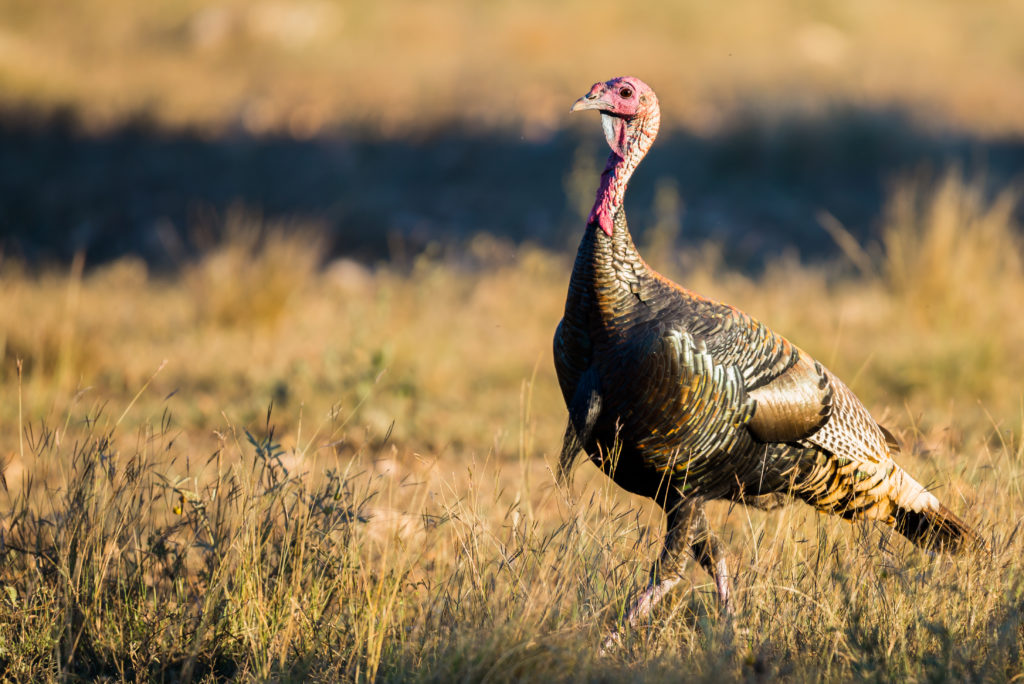A Bird Called Blinky
Some tom turkeys just have a way of getting under a hunter’s skin. This is a tale of one such bird.
By Jim Spencer
I’d been hunting turkeys only seven or eight years when I met the turkey I eventually named Blinky. He lived on an unusual land feature for the Ouachita Mountains — a steep-sided ridge shaped like a New Mexico mesa.

Some gobblers just have a way of getting under a turkey hunter’s skin. Blinky was one of those birds. (Photo: GettyImages.com)
The sides of this thing weren’t quite vertical, but steep enough that you needed both hands and both feet to climb the 600 feet to the top. Once you got up there it was flat as a football field, about 200 yards wide and 600 yards long, well-timbered with a mixed stand of oak, hickory and shortleaf pine and not much undergrowth.
In other words, it was a good place for a gobbler to strut and show off his fine self, and this old boy liked it just fine. I heard him one morning from the road that ran along the base of the ridge’s south side. Because of the distance to the top and the fact that he wasn’t close to the edge — and also because years of unprotected shooting have taken their toll on my eardrums — I could just barely hear him. It was a workday and already well past sunrise, and I could tell from eyeballing the steep slope I didn’t have time to get up there to him. So I listened to him for a while and drove back to town.
That was a Wednesday. On Thursday I stopped at the same spot on the road below the mesa and heard him again, way up there on top. Ditto Friday. Guess where I was at first light Saturday?
If you’ve never climbed a cow-face slope made of shale and loose chunk rock in the dark with a shotgun slung across your chest and a Mini Mag light in your mouth, let me give you some advice: Keep it that way. Somehow I made it to the top without performing a Humpty Dumpty, and with enough time to spare to catch my breath and ease my cramping fingers and forearms before gobbling time. Since I’d never been up there before and didn’t know where on the mesa the tom was roosted (if he roosted there at all), I didn’t want to risk moving around on the flat until I knew more about the situation. Even though I was a relative newcomer to turkey hunting, I’d still bumped a hell of a lot of gobblers by blundering under their roost trees in the near dark. So I eased to the base of the nearest tree, leaned my gun against the scaly bark and sat down.
The Sound of Disrespect
Plop! Plop-plop! The first plop was right beside me on the pine needles. The second was on the bill of my cap and my left shoulder. Exploring fingers revealed the awful truth: turkey turds. As the light grew (interminably slowly) and the woods began to wake up, so did the gobbler’s bowels directly overhead. He bombed me twice more in the next 30 minutes, and then he started gobbling. By rolling my head to the side I could peer into the tree and see him, 15 yards above, and I could have rolled him off the limb any time I wanted. But even back then I didn’t want to kill turkeys that way — not even turkeys that had disrespected me like this one had. So I waited. And waited.
Finally he flew down, gliding silently through the big timber and landing barely in sight at about 90 yards. He immediately went into strut with his tail toward me, and I took the opportunity to wipe the biggest part of the turkey crap off myself. Then I eased my gun down from its leaning place against the tree, slid a diaphragm call onto my tongue and answered him the next time he gobbled.
I’ve never had much luck calling a gobbler back to the vicinity of his roost tree, and luck ran true to form that morning. He turned around and looked my way, gobbled a time or two, but when he started moving it wasn’t in my direction. I let him get out of sight and then angled his way, using the break of the slope to hide my advance.
It was a typical, frustrating, unsuccessful morning. The tom strolled around on his flat mountaintop, gobbling at my calls, crows, blue jays and anything else that struck his fancy, and after a while he shut up and I lost track of him. I stayed up there until the middle of the day, but I never heard him gobble after 8 o’clock. Flicking remnant specks of turkey poop off my clothes, I descended the slope faster but with no less difficulty than I’d climbed it six hours earlier.
Sunday morning I climbed the ridge 200 yards farther north, in case he was roosted in the same vicinity. He was, and it sounded like he was in the same tree. I closed the distance in the predawn dark and set up as close as I could to where he’d pitched down the morning before. Naturally, he flew out the other way. I followed and we played a repeat of Saturday’s hunt. But at least this time I didn’t go home smelling like the floor of a turkey house.
Spring Project
Arkansas had a 37-day turkey season in those days and this was before I became a traveling turkey hunter, so this mountaintop bird became my project for the season. You know how it is; a bird gets inside your head, and nothing seems as important as killing him. During the decades since, I’ve figured out the best thing to do is write off birds such as this, but I didn’t know it then.
So I wasted the second half of that season trying to kill an unkillable turkey. Unkillable by me, at least. I didn’t go to him during the week because of time constraints, but the last three weekends of the season I climbed that damned ridge both Saturday and Sunday and stayed up there most of the morning. I made contact every day I was up there, saw him three or four times, but never got him any closer than 60 yards. I tried using a decoy, I tried building a brush blind, I tried stalk-and-bushwhack. The season ended with that sneaky tom still strolling around on top of the mesa and me grinding my teeth.
Opening day the next year I was on the mesa again. I’d heard him up there on two scouting mornings, but hadn’t climbed to the top. But I was waiting for him to open up on the first morning and he didn’t disappoint. He was 150 yards away, and as I closed the distance I came to small patch of wind-thrown trees that had come down sometime during the off-season. There were five or six of them, scattered over about an acre, and I found a comfortable spot against one of the root balls.
The gobbler seemed more interested this time, and when he hit the ground he headed my way. I saw him at 80 yards when he came through a gap between two big oaks, and then he slipped behind one of the blowdowns. I saw him again at 25 yards, on the other side of the blowdown, looking at me through a saucer-sized hole. I already had the gun shouldered and ready, and I could have busted him right then. But I wanted him in the open, so I waited.
It was a standoff. His black, shiny eye was centered in the hole, his white head as big as a softball. I was a wreck, trembling like a sick dog. I remember thinking: Be still. Be Calm. Wait him out. Don’t do anything stupid.
And then, of course, I did something stupid. It never occurred to me that if I could see his eyeball through that hole, he could see mine as well. But he could, and when I blinked, things went south in a hurry. The gobbler couldn’t have reacted more violently if I’d hit him with a cattle prod. He got airborne in a tenth of a second, and although I could have busted him out of the air when he cleared the top of the blowdown at point-blank range, I was too flabbergasted to pull the trigger.
He sailed over the edge of the ridge and out over the road far below, and from my seat against my fallen tree I watched him sail across a wide valley and land on the slope of another ridge a thousand yards away. All I could think of to do was shake my head and grin.
I climbed up there three more times during the course of that season, but I never saw or heard that turkey again. And now you know why I named him Blinky.
